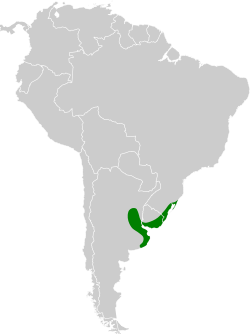Description
The curve-billed reedhaunter is 15 to 17 cm (5.9 to 6.7 in) long and weighs 27 to 30 g (0.95 to 1.1 oz). It is a small furnariid whose plumage closely resembles that of some Old World reed warblers of genus Acrocephalus . It has a long and quite decurved bill. The sexes' plumages are alike. Adults have a whitish supercilium, an ill-defined dark brown band behind the eye, lighter brown ear coverts with some thin whitish streaks, and a whitish malar area. Their crown, nape, back, rump, and uppertail coverts are rich brown; the brown is darkest on the crown and gradually becomes more rufescent to the uppertail coverts. Their wings and tail are rufescent brown. Their throat is whitish, their breast more buffy, their belly creamy buff, their flanks cinnamon-buff, and their undertail coverts a rich buff. Their iris is brown, their maxilla brown to blackish, their mandible a whitish and brownish mix, and their legs and feet grayish. [6]
Behavior
Movement
The curve-billed reedhaunter is a year-round resident throughout its range. [6]
Feeding
The curve-billed reedhaunter feeds on a variety of adult and larval arthropods that it gleans from marsh vegetation. It usually forages by itself. [6]
Breeding
The curve-billed reedhaunter is assumed to breed during the austral spring and summer, and is thought to be monogamous. It constructs a ball-shaped nest of grass, leaves, and other fibers and lines it with softer plant material. The nest has a side entrance, usually with an overhanging "awning". It attaches the nest to reeds or atop vegetation. The clutch size is two eggs. The incubation period, time to fledging, and details of parental care are not known. [6]
 | Songs and calls
|
Vocalization
The curve-billed reedhaunter's song is a "fast series of harsh notes that ascend and then descend in pitch, fading towards [the] end". Its call is "a hollow 'took' ". [6]
This page is based on this
Wikipedia article Text is available under the
CC BY-SA 4.0 license; additional terms may apply.
Images, videos and audio are available under their respective licenses.




